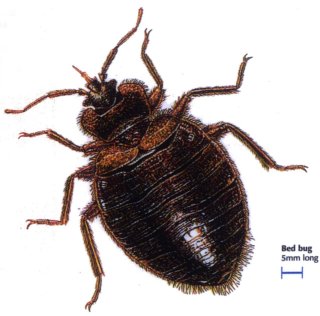
How do you know if you have them?
Although bedbugs are visible to the human eye they conceal themselves very well and most of the time remain undetected by hiding in cracks and crevices in your home.
A very good method of gauging if you have bedbugs is by applying double sided sticky tape on all sides of your bed frame, thereby catching them or even as a temporary measure to help against immediate biting as the host sleeps.
These insects need to be close to a host for an extended period. Infestations occur mainly in the bedroom and living areas, if bedbugs are in the bedroom they will come out at night while the host is sleeping. Bedbugs will hide in bedframes, headboards, wardrobes, bedside cabinets, in cracks in woodwork and plaster and behind any loose or peeling wallpaper. In the living area, they prefer soft furnishings and are often found around the arm joints of armchairs and sofas, bedbugs also hide under carpets. Black dots that are closely bunched together are signs of bedbug faeces.
Adult bedbugs are 4 – 5 mm in length, wingless and mahogany brown in colour. They have long well-developed walking legs with efficient tarsal claws for clinging on to the host during feeding. They have prominent antennae which project from the head and are adjacent to the compound eyes.
The initial warning that you have a large and growing infestation is that you will be bitten. The resulting irritancy of the anti-coagulant chemical around the bite site can be severe and especially so to people with sensitive skin. Scratching can cause infection of the bite area and you should consult a doctor or chemist to obtain appropriate medication.
Bedbugs are more active at night, the bedbug feeds on the host by finding a bare patch of skin through which it forces the feeding tube of its mouthparts whilst at the same time injecting the host with its saliva. The saliva contains a chemical that prevents the blood from clotting and it is this substance that causes the itching and swelling associated with the ‘bite’. The bite from this insect can be very irritating, and although rare, some hosts may become anaemic through blood loss.
How do we control bedbugs?
A thorough inspection should be made to determine the extent and source of the infestation. Bedbugs can be introduced via second hand furniture, been brought in by the resident or entered the building through neighbouring premises.
Treatment for bedbugs is detailed and complex. We would normally carry out three visits against bedbugs. Our initial treatment consists of a dual insecticide treatment to the entire premises apart from the kitchen and bathroom. Before the treatment commences the residents are asked to vacate the premises and cannot return for four hours.
Follow up visits
We would need to carry out two follow up visits at weekly intervals after the initial treatment and the premises are treated in exactly the same way as the initial visit. Once our work is completed our technician will fill out a detailed inspection report and discuss ways of preventing re-infestation.
